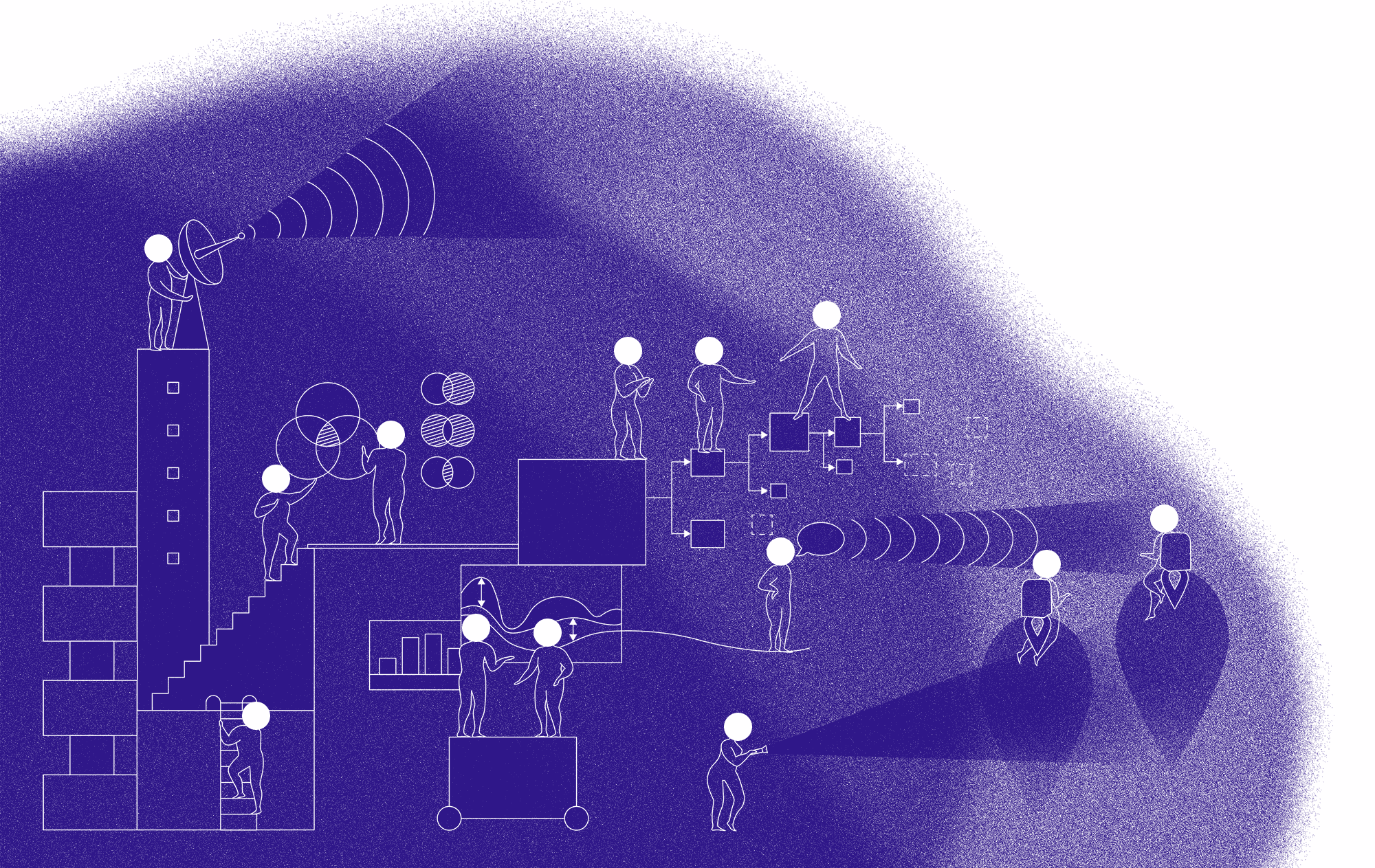Note from the Editors
UNHCR Innovation Service’s “Orbit 2018-2019” is a collection of insights and inspiration, where we explore the most recent innovations in the humanitarian sector, and opportunities to discover the current reading of innovation that is shaping the future of how we respond to complex challenges.
In this publication, we examine issues from climate change and the future of displacement to how we can utilise storytelling as a key tool for making innovation accessible for everyone. We look at the assumptions behind why innovation thrived in UNHCR Brazil and how humility led UNHCR Mexico to drop humanitarian logos and focus on communicating with people on the move in new and unforeseen ways. We explored the tension between bureaucracy and creativity and studied what community-led innovation truly looks like in practice. We’ve brought voices from across UNHCR to help us unpack the role that innovation plays our day-to-day work in serving refugee populations and how it might shape the future of our work for the better.
We’ve also asked a lot of questions in 2018 to frame our approaches and path moving forward. For example, how might we move from seeing connecting refugees as a technology issue to one grounded in rights and normative values? And, how can we influence better decision-making through the innovation process?
Read the rest of the note here.
Our latest stories
For the sake of the future, innovate courageously
For the future of UNHCR, and indeed the UN, we will need braver approaches and we will need more courage to do it. Limiting ourselves to cookie-cutter solutions will only relegate innovation to a gentle tinkering around the edges.
A New Compass: Navigating the dark matter of institutional innovation
Within UNHCR, there are spaces that exist in the gaps between bureaucratic processes and services; spaces that often go undetected. To prepare UNHCR for the future, we need to innovate the organisation’s back-end processes and structures.
Why community-led innovation is fuelled by risk, ambition, and experimentation
The Community Technology Empowerment Network (CTEN) is a refugee-led organization based out of Rhino Camp Settlement in Uganda. CTEN’s Co-Founder tells his story of hope in new ideas, persistence and experimentation in Uganda.
Humility over brand - a new approach to social media for those on the move
UNHCR Mexico wanted to move away from humanitarian branding and logos as it was felt that something more compelling could be created that breaks with communities’ preconceptions of humanitarian support. Here’s how they did it.
The Void: Building trust for Artificial Intelligence in the humanitarian context
We believe that resistance is actually a lack of clarity. So, how might we create a pathway for harnessing the potential of AI in humanitarian innovation? We outline actions you can start taking to put out the flames of fear around artificial intelligence.
How UNHCR Brazil harnessed the power of innovation
What does innovation look like in a rapidly changing environment? We look at the assumptions behind why innovation thrived in UNHCR Brazil and outline how other operations can create their own safe space for innovation.

More digital stories are on their way.
But if you can’t wait – you can download the full publication here.

Why is innovation so difficult? An ode to all innovators.
By Emilia Saarelainen, Innovation Fellowship Programme Manager
We all know that innovation is hard, but why exactly is it so difficult?
Innovation is about people
Before we can even start talking about the difficulties of the actual act of innovating, we need to be clear on what we mean by innovation and what’s needed to innovate.
Innovation doesn’t happen without innovators. Innovation is not about finding the new bright idea, it’s not about having all types of processes in place and it’s not about technology. It’s about people, those ones who are passionate about what they do and want to drive change. People are the backbone of innovation. And that’s exactly the reason why it’s also so difficult. People, you and I, us and them, are required to make innovation to happen, but we are also part of the problem and a reason why it is so difficult.
We have a very limited understanding about who is and who can be an innovator. An innovator is seen to be a lone inventor, an Einstein type of individual (usually a white man) sitting alone in a basement and coming up with new ideas. Innovation is often understood as “the best idea” and an innovator as the one having a light bulb moment magically leading to a successful implementation. This narrative is misleading as innovation is not just about generating ideas and innovators are not just inventors. Anyone can innovate, regardless of age, nationality, position or gender. Innovators have the right attitude, a creative mindset, and an ability to see things differently and bend the boundaries. And most importantly, they have a desire to solve complex challenges – and given the right tools, attitude and environment, each person has the power to create change.
Innovation requires a wide range of skills
When we talk about innovation skills, we typically talk about just one type of skills, creative (thinking) skills, i.e. an individual’s ability to generate new ideas, solve problems and think creatively. We think about artists or entrepreneurs who seem to have creativity as a gift to do something magical (while the rest of us just admire it from aside). But this is misleading because, first of all, innovation skills are not just about creativity skills and second, being innovative is not the privilege of a few select persons; it’s possible to learn how to be creative and how to be innovative. There are tons of tools and techniques to help you to enrich your creative skills, i.e. have new ideas, think creatively, overcome your thinking habits, etc. Additionally, there are innovation tools, methods, and guidebooks that help you to go through the rest of the innovation process and provides tools for identifying a problem, test assumptions, design and guide through an experiment, etc.
So, the good news is that anyone can learn to use innovation tools, the bad news is that it might be the easiest part. Innovation is not just about tools and methods, but it’s also, and even more about mindset. Innovation is an iterative process, uncertainty and unknown being an inevitable part of it. Going through that process requires one being comfortable with confusion, failures, and disappointments and it’s not always easy or pleasant. Innovating can be nerve-wracking, uncomfortable or even scary. There’s no toolkit to help you to teach it or prepare for it, the only way to learn it is to go through it, experience it and learn by doing. As an innovator, you need to be persistent and have resilience for all this.
And as if this would not be enough, there’s a third set of skills that is important, especially for those innovating in a large organisation: communicating, influencing, and convincing. Whatever you want to do, it needs to be shared with many different actors in the organisation. It needs to be communicated in the right way to the right people in order to make anything happen. And often making the case isn’t sufficient, facts don’t convince people, but you need a strategy on how to get people on board and make the change. Innovators don’t act in isolation, they are working in a specific operational and political environment that they need to know how to navigate.
Innovation is not something you can learn just from books. There are tools and methods available for innovators, but they cover only a small part of skills one needs to innovate. Also, tools and methods don’t mean much, if they don’t lead to a change in behaviours and habits. And in order for innovation to be fully practised in daily work and for it to become a habit, you need time, effort and practice. It’s about creating “muscle memory” for innovative ways of thinking and acting. The only way to learn innovation is to actually take action and do things.
No one can innovate alone
Anyone can be an innovator, but no one can do it alone. The range of skills needed to innovate is so large that it is unlikely that one individual will be strong on all of them. Needed skills are also changing throughout the process (for example, idea generation requires different types of skills than scaling), individuals simply can’t have them all. So, we need to work with others, we need teams to innovate.
Innovation is all about collaboration. At its simplest, collaboration means working with others to achieve something. However, as we know, in reality working with others is not always that easy. It can feel frustrating, draining and unproductive. The more diverse the team is, the harder the collaboration can be (but the outcomes are better). There are more perceptions and different viewpoints to consider, a greater exchange of knowledge, decision making takes more time, and there’s always a possibility for a conflict. For individuals wishing to innovate this means yet another set of skills for them to master- collaboration skills. Collaboration requires a high level of trust and emotional intelligence. For talkers, it might be difficult to be quiet and listen (actively!), for less talkative and/or reserved people, it can be difficult to make themselves heard; you need to be able to communicate your point of view openly and effectively and be willing to compromise; and you must have the ability to be tolerant and accepting of others. People need to be able to let go of control and their own ego and believe that collaboration and working with others will bring possibilities to create something greater than working alone would.
If collaboration is hard for individual team members, it’s also hard for supervisors and managers trying to manage and support a diverse team. Too often we assume collaboration will happen when a group of people are put together. It doesn’t. It requires goals and methods and a lot of it depends on managers’ skills to create an environment fostering and supporting collaborative efforts.
People need to be taught to act together in multidisciplinarity to develop novelty into innovation, supervisors and managers need to be taught to lead and manage teams and collaborative work, and the leadership need to set the tone for a true collaborative organisational culture.
We are afraid of innovation. All of us.
Innovation is scary, but what exactly are we afraid of? Well, we experience the fear of making a mistake, failure, unknown, uncertainty, looking foolish, being different, losing control, disappointing ourselves, disappointing others, imperfection, taking the first step, taking a risk, getting no rewards, rejection, losing face or prestige, being judged, thinking we are not creative, and change – just to name a few.
Fear is a strong emotion as it prepares us to react to danger. It can slow some functions of our body down, while sharpening other functions helping us to survive. These are normal reactions, our brains are just trying to protect us from harm, but it’s not pleasant to experience them and the natural reaction is to avoid them. Fear can paralyse us from taking action and ultimately, hold people back. Therefore, fear is not a friend of innovation, so we need to find ways to deal with the emotion that hinders it and thus, in order to find a coping mechanism with innovation fears, we need to understand them better. Here’s a list of three of the biggest fears associated with innovation.
1. Fear of unknown
The dominant and the strongest fear of all is the fear of unknown. By nature, most of the people tend to prefer certainty. The problem is that innovation by its nature is characterised by uncertainty. In innovation (jargon), this uncertainty is often divided into two: there are known unknowns and unknown unknowns. Known unknowns are something that we know we don’t know. There are risks involved in such situations, but they can be calculated and managed with risk management, which reduces the uncertainty and provides us with some kind of feeling of certainty. Whereas, unknown unknowns are something that we don’t know that we don’t know. It’s a kind of uncertainty that can’t be dealt with risk management, it can only be managed by experimenting and learning. Preparing yourself or your team for the uncertainty and unforeseeable is difficult, if not impossible. You are asked to jump in and to try something of which the outcome is uncertain. The fear of the unknown leads to problems in dealing with uncertainty. Something unexpected might happen, which would be different from what people are used to. No guidebook can prepare you for how it feels to be in the middle of uncertainty without being sure of what direction to take. Essentially, managing innovation is about mastering uncertainty.
2. Fear of failure
Most individuals, managers, and organisations are fearful of making mistakes. Failing is considered shameful and painful. However, failure is an inevitable part of innovation. It doesn’t mean that failing more often would directly lead to innovation, of course not, but more frequent trials (with learning from them) most likely do. And the more trials you do, the more unsuccessful trials (or better to say, trials with negative results) you may experience – and that may feel like a failure. Fear of failure keeps us from taking a step into the unknown, and not even trying and that paralyses innovation. It’s normal to experience fear of failure as most of us have gone through an education system that taught us that failure isn’t a positive thing. We were rewarded only for the best grades and taught that we always have to know, we always have to win. But innovation doesn’t work like that – it doesn’t flourish in such an environment. There isn’t always one right answer, you may need to try (and fail) several times before succeeding. And you might still not succeed. But what is comforting is that fear of failure is mostly a learned emotion and we can unlearn that.
3. Fear of risk-taking
Most people are risk-averse and would prefer to go with a tried and tested solution rather than taking their chances on an unproven solution. Taking the known solution, playing safe is comfortable as it makes us feel in control. Innovating is the opposite. There’s no feeling of control and it gives you a sense of insecurity. Risk-taking is scary because nobody knows if the risk you take will pay off (that’s why it is called risk). But any kind of development is impossible if you never take any risks – especially if you wish to try and build something completely new, some level of risk is inevitable. It is easier to embrace the risk, if we understand what we mean by risks. In its simplest form, risk can be considered as something that can lead to a damage, this can be for example a financial loss, reputational damage or in the worst case, harm caused to people we try to help. So risks should be taken seriously, but they should not prevent us innovating. Taking a risk doesn’t need to mean to bet everything, there are ways to mitigate the risk (for example: through experimenting and learning). It is also good to remember that doing nothing, inaction, can also be a risk. Often the fear is bigger than the risk itself.
All these fears are normal, and they don’t only cause fear to innovate, but they also may prohibit others from innovating. Managers and organisations experience exactly the same fears of the unknown, failure, and risk-taking as individual innovators or teams do, but their fears are often turned into resistance. So even if you as an innovator have managed to overcome your fears (or more likely, to act despite your fears), you still have to persuade the others to come to your side. So, it’s actually not enough to deal with your own fears, you need to find a way to deal with other people’s fears as well.
There’s always resistance
There’s resistance to innovation, because there’s resistance to change. People don’t like to change. People like the status quo and we want things to be as they are (sometimes even if we claim otherwise). How often have you heard managers and organisations praising innovation, but when it comes to action they tell you “We can’t do that, because that’s not the way we do things here,” or “We have tried this before and it doesn’t work.” What do you do with all these innovation competences and enthusiasm, if there’s no space to use them? Typically, large organisations are designed to execute and be efficient, not to innovate. They are built for short-term performance, not for innovation. So, in a way innovators go against what the organisations are designed for. Organisations do need traditionalists too, they have a role in organisations, but they don’t always make innovators’ lives easy.
Innovation requires that managers at all levels of the organisation encourage, and create the space for staff to innovate and experiment in their day-to-day work. They must decrease fear of failure and create an environment of psychological safety. The real innovation challenge is overcoming organisational resistance.
Innovating is difficult because innovation is difficult. It’s not just about learning tools and methods but it touches upon a variety of emotions (innovators as well as others) and it’s embedded into experimentation, collaboration, and diversity. It’s about going through a journey that can be unpleasant, lonely, and scary and it requires people who have passion, drive, and resilience to go through it all.
Innovators, praise yourselves. You are superstars.






